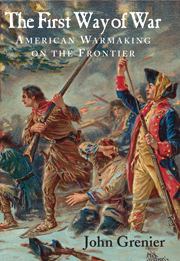Book contents
- Frontmatter
- Contents
- List of Figures and Maps
- Preface
- Acknowledgments
- List of Abbreviations
- Introduction
- 1 The First Way of War's Origins in Colonial America
- 2 The First Way of War in the North American Wars of King George II, 1739–1755
- 3 Continental and British Petite Guerre, circa 1750
- 4 The First Way of War in the Seven Years' War, 1754–1763
- 5 The First Way of War in the Era of the American Revolution
- 6 The First Way of War in the 1790s
- 7 The First Way of War and the Final Conquest of the Transappalachian West
- Epilogue
- Index
6 - The First Way of War in the 1790s
Published online by Cambridge University Press: 05 June 2012
- Frontmatter
- Contents
- List of Figures and Maps
- Preface
- Acknowledgments
- List of Abbreviations
- Introduction
- 1 The First Way of War's Origins in Colonial America
- 2 The First Way of War in the North American Wars of King George II, 1739–1755
- 3 Continental and British Petite Guerre, circa 1750
- 4 The First Way of War in the Seven Years' War, 1754–1763
- 5 The First Way of War in the Era of the American Revolution
- 6 The First Way of War in the 1790s
- 7 The First Way of War and the Final Conquest of the Transappalachian West
- Epilogue
- Index
Summary
In September 1792, in response to ongoing Creek and Chickamauga raids on American settlements in the Old Southwest, Robert Anderson penned a terse letter to his state's governor. With the Indians capitalizing on their “skulking, wolfish advantages” to pillage outlying farms, Anderson contended that it was “hazardous, and distressing, to carry on a defensive war” against them. He therefore proposed that Georgia, South Carolina, and North Carolina pool their militias – men “well calculated for such enterprise” – to put over 5,000 infantry and 500 cavalry in the field. The states' militias could then “march through and destroy the disaffected Cherokee (Chickamauga) towns, which would be just on their way, and meet in the Creek country, destroy what they could, and so return.” Since the Indians were not “so well calculated to oppose a spirited attack in their country,” Anderson believed that two months of hard campaigning would compel them to sue for peace.
The full-scale, coordinated invasion of the Creek country for which Anderson called never materialized. Although Governor Edward Telfair of Georgia was willing to commit a portion of his militia to such a campaign, the leaders of North and South Carolina did not offer up their troops. The federal army, meanwhile, consisted of only a small fighting force. The South, moreover, was not a priority; the War Department had stationed the great majority of federal troops near the Ohio country to counter the Indian threat there.
- Type
- Chapter
- Information
- The First Way of WarAmerican War Making on the Frontier, 1607–1814, pp. 170 - 203Publisher: Cambridge University PressPrint publication year: 2005



